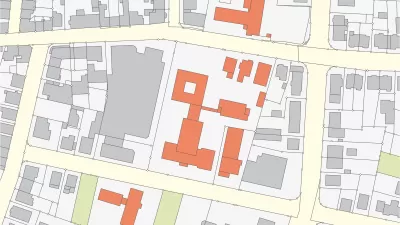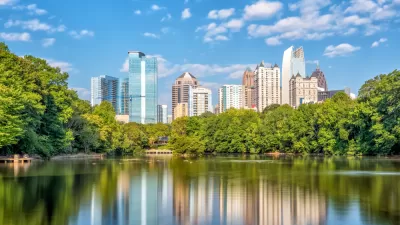A few years ago, someone asked me the following question (loosely paraphrased) on a listserv: “Since the most tradition-minded* religious Jews are required by Jewish law to walk to synagogue on Sabbaths and holy days (and thus presumably prize walkability) why aren’t they a major market for new urbanist developments?” At the time, I didn’t have a coherent answer. But now that I know more about both traditional Jews and new urbanism, I do.
A few years ago, someone asked me the following question (loosely paraphrased) on a listserv: "Since the most tradition-minded* religious Jews are required by Jewish law to walk to synagogue on Sabbaths and holy days (and thus presumably prize walkability) why aren't they a major market for new urbanist developments?" At the time, I didn't have a coherent answer. But now that I know more about both traditional Jews and new urbanism, I do.
A new development (new urbanist or otherwise) far from an existing congregation may have difficulty attracting the most tradition-minded Jews, for the simple reason that most such Jews would rather live near a preexisting congregation than move elsewhere, pray at home for a few years, and wait for enough people to follow them for a congregation to emerge. (Of course, it does happen now and then).
To be sure, a congregation does occasionally move en masse- but given that congregants have investments in existing housing, this rarely happens (except perhaps in times of rapid neighborhood transition, such as the third quarter of the 20th century when many urban neighborhoods switched from all-white to all-black over a very short period of time).
Of course, an infill new urbanist development could be located near an existing congregation. But infill developers will not always be able to get large numbers of observant Jewish customers. Here's why: new housing usually tends to be more expensive than old housing. But the most traditional Jews tend to have less money to spend on housing than the most affluent buyers, for two reasons.
First, among Jews (as among Christians) the most religiously traditional people tend to have the largest families. Lots of mouths to feed mean less money to spend on housing, which is why Orthodox Jewish communities (where the majority of congregants usually walk to synagogue) are rarely in a city's most expensive neighborhoods, except in large cities with lots of Orthodox communities. Second, large families usually need more space than small families, which means that if a large, religiously traditional Jewish family has extra housing dollars to spend, it will spend those dollars on extra space rather than on a newer house.
As a result of these factors, the most observant Jews tend to be disproportionately attracted to older, not-too-expensive inner suburbs: older because (as noted above) any new development will not immediately attract a critical mass of religious Jews, inner suburban because inner suburbs usually have cheaper housing and more space than downtown neighborhoods. For example, in Atlanta the center of Orthodox Jewry is Toco Hills, a 1950s suburb just past the city limits of Atlanta.** Indeed, I would posit that religious Jews are to 1950s suburbs what gays and artists are to intown neighborhoods: a group disproportionately attracted to neighborhoods that might deteriorate in the absence of that group's presence.
*Usually Orthodox, but not always: not all Jews belonging to Orthodox congregations have taken on this religious obligation, and a minority of non-Orthodox Jews have done so.
**Although there are Orthodox congregations outside Toco Hills, my sense is that their members tend to be less religiously strict than those of the Toco Hills congregations. Similarly, in some other cities where there are multiple Orthodox communities, the strictest tend to be in middle-aged suburbs or "outer borough" city neighborhoods rather than in downtown or the newest suburbs. For example, in Philadelphia, the most strict Orthodox Jews tend to be in inner-suburban Northeastern Philadelphia, while downtown Philadelphia's Orthodox Jews tend to be more moderate.

Planetizen Federal Action Tracker
A weekly monitor of how Trump’s orders and actions are impacting planners and planning in America.

Restaurant Patios Were a Pandemic Win — Why Were They so Hard to Keep?
Social distancing requirements and changes in travel patterns prompted cities to pilot new uses for street and sidewalk space. Then it got complicated.

Map: Where Senate Republicans Want to Sell Your Public Lands
For public land advocates, the Senate Republicans’ proposal to sell millions of acres of public land in the West is “the biggest fight of their careers.”

Maui's Vacation Rental Debate Turns Ugly
Verbal attacks, misinformation campaigns and fistfights plague a high-stakes debate to convert thousands of vacation rentals into long-term housing.

San Francisco Suspends Traffic Calming Amidst Record Deaths
Citing “a challenging fiscal landscape,” the city will cease the program on the heels of 42 traffic deaths, including 24 pedestrians.

California Homeless Arrests, Citations Spike After Ruling
An investigation reveals that anti-homeless actions increased up to 500% after Grants Pass v. Johnson — even in cities claiming no policy change.
Urban Design for Planners 1: Software Tools
This six-course series explores essential urban design concepts using open source software and equips planners with the tools they need to participate fully in the urban design process.
Planning for Universal Design
Learn the tools for implementing Universal Design in planning regulations.
Heyer Gruel & Associates PA
JM Goldson LLC
Custer County Colorado
City of Camden Redevelopment Agency
City of Astoria
Transportation Research & Education Center (TREC) at Portland State University
Camden Redevelopment Agency
City of Claremont
Municipality of Princeton (NJ)






























